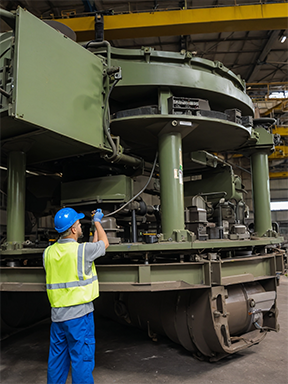Published: February 18, 2025 | Updated: October 21, 2025
Published: February 18, 2025 | Updated: October 21, 2025
Corrective vs. Preventative Maintenance: Choosing the Right Strategy for Your Assets
When companies develop a maintenance plan, they have several choices. In this article, we'll look at two types: preventive and corrective. Included in this discussion:
- Definitions and traits of each.
- Advantages and disadvantages of each.
- Considerations for using each (or both).
- Benefits of a computerized maintenance management system (CMMS).
 What Is Corrective Maintenance?
What Is Corrective Maintenance?
This means you don't tend to assets until after something happens. A breakdown, a failure, etc. You correct the problem to restore the asset to an operational state.
Examples: You repair a processor after gears lock up. You replace a gutter after it falls. You change a light bulb when it burns out.
Keep in mind that maintenance departments conduct corrective-type activities all the time. In fact, a CMMS might have this as one of the types when you create a work order. This gives the technician more information about the job.
Many times, a worker might make a "quick fix." While this may solve the issue, there might be an underlying problem. Look for repair patterns. If you see constant similar repairs, you should consider investigating a root cause.
When you consider this type of maintenance, you must be aware of costs. If you run strictly by a corrective mindset (a reactive mindset), then you save costs upfront. You have a lower overhead of parts and supplies.
However, you also risk higher costs when you have repeated unplanned downtime. And if that downtime runs for longer periods, what happens to production?
One solution: Use corrective maintenance for non-critical assets. Judge which equipment won't severely affect production. You may choose not to conduct preventive maintenance (PM) on these. Instead, you'll make corrective repairs or consider purchasing a replacement.
 What is Preventative Maintenance?
What is Preventative Maintenance?
Most companies use some form of this type. This mindset gets you working proactively to stave off breakdowns and failures. It helps reduce unplanned downtime.
It relies on overhead, so you do incur upfront expenses for purchases. However, over the long run, you'd save money for lengthy repairs or replacement equipment before you'd expect to.
Advantages and Disadvantages of Preventative Maintenance
PMs also extend asset lifespan. Regular inspections, lubrication, cleaning, etc. keep those assets operating at a desired baseline. Over time, that level will lower, but you strive to keep it as high as you can.
Preventive activities also reduce safety problems. For example, through a routine inspection, you repair a loose protective guard.
PMs help fulfill your goal of keeping assets at their peak performance levels. For example, the machine produces 10 widgets per hour. An inspection reveals a problem that has hampered the ability to produce 15 widgets per hour.
With this strategy, you can keep compliant with manufacturers and other regulatory guidelines.
One of the disadvantages of this strategy includes over-maintenance.
First, this tends to interrupt production.
Second, too much attention incurs more costs.
Third, some PMs won't benefit the asset. For example, over-lubrication can detrimentally affect a machine.
Using a CMMS solves this over-maintenance issue. You create a list of PMs and note their cycles. Proper scheduling on a CMMS calendar keeps you from assigning the same PM too often.
How to Choose Between Corrective and Preventative Maintenance
Consider a hybrid method. Discuss the plan with your department. Establish PMs and note which assets can remain at corrective maintenance status. However, take into account the following when making decisions:
⮚ Critical systems. I mentioned this before. These assets don't necessarily need PMs. You might choose to service these once in a while, but, again, they don't harm production too much if they fail.
⮚ Maintenance history. Once again, your CMMS shines in this area. Generate a report that shows the history of repairs and PMs of a particular asset. You might find that you need to move a once non-critical machine over to a higher priority.
⮚ Compliance issues. Neglecting routine maintenance risks fines or worse from regulators and agencies.
⮚ Asset age and condition. Has the machine depreciated enough over the years that further maintenance outweighs replacement? Perhaps all those "quick fixes" over time have left the machine unstable and unsafe.
⮚ Follow the manufacturer's guidelines. Read the recommendations from the company from whom you purchased the asset.
⮚ Safety. It needs to come first. How much do you risk with either only corrective measures or only preventive practices?
The Use of a CMMS in Corrective and Preventive Maintenance
I've mentioned this system throughout this article. With CMMS software, you have better organization to your existing maintenance plan. Included benefits:
⮚ Asset management. Create your lists of assets with all pertinent data. Track equipment readings and depreciation values.
⮚ Inventory management. Maintenance requires parts and supplies. With a CMMS, you have automatic updates on quantities, parts location, assigning parts to assets, and so much more.
⮚ PM. Create your list of PMs and assign them to assets. Mark priority and cycles.
⮚ Work order processing. A CMMS helps you process work requests and create concise and informative work orders. Assign labor and schedule jobs. Add checklists and safety documentation.
⮚ Reports. I mentioned these earlier. Look for a quality CMMS that offers reports that you can narrow to only what information you want. Use these to study your operations and look for improvements.
The Best Approach to Maintenance Management
Do you use corrective or preventive maintenance? You should consider both. You probably already do use both. Of course, you'll send technicians out to fix a broken or failing piece of equipment.
Review the advantages of PMs. In the long run, you'll save expenses.
FAQs
What is corrective maintenance?
Corrective maintenance is performed after a failure occurs to restore equipment to operational status.
What are the benefits of preventative maintenance?
Preventative maintenance reduces unplanned downtime, extends asset lifespan, and helps maintain peak performance.
How can a CMMS improve maintenance management?
A CMMS organizes assets, schedules preventive tasks, tracks inventory, and simplifies work orders.
When should a company choose corrective over preventative maintenance?
Use corrective maintenance for non-critical assets that won’t severely affect production if they fail.
How does MAPCON CMMS help with preventive maintenance?
MAPCON CMMS schedules PMs efficiently, avoiding over-maintenance and ensuring tasks occur at the right time.
What factors should influence a maintenance strategy?
Consider asset criticality, age, compliance requirements, safety, and maintenance history when choosing your approach.
MAPCON | 800-922-4336
MAPCON CMMS software empowers you to plan and execute PM tasks flawlessly, thanks to its wealth of features and customizable options. Want to see it for yourself? Click the button below to get your FREE 30-day trial of MAPCON!
Try It FREE!